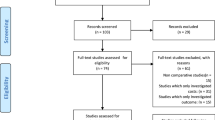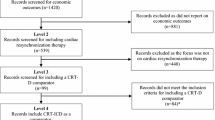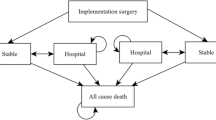Abstract
Purpose of Review
Heart failure (HF) is a major public health problem worldwide, affecting more than 64 million people [1]. The complex and severe nature of HF presents challenges in providing cost-effective care as patients often require multiple hospitalizations and treatments. This review of relevant studies with focus on the last 10 years summarizes the health and economic implications of various HF treatment options in Europe and beyond. Although the main cost drivers in HF treatment are clinical (re)admission and decompensation of HF, an assessment of the economic impacts of various other device therapy options for HF care are included in this review. This includes: cardiovascular implantable electronic devices (CIEDs) such as cardiac-resynchronisation-therapy devices that include pacemaking (CRT-P), cardiac-resynchronisation-therapy devices that include defibrillation (CRT-D), implantable cardioverter/defibrillators (ICDs) and various types of pacemakers. The impact of (semi)automated (tele)monitoring as a relevant factor for increasing both the quality and economic impact of care is also taken into consideration. Quality of life adjusted life years (QALYs) are used in the overall context as a composite metric reflecting quantity and quality of life as a standardized measurement of incremental cost-effectiveness ratios (ICER) of different device-based HF interventions.
Recent Findings
In terms of the total cost of different devices, CRT-Ds were found in several studies to be more expensive than all other devices in regards to runtime and maintenance costs including (re)implantation. In the case of CRT combined with an implantable cardioverter-defibrillator (CRT-D) versus ICD alone, CRT-D was found to be the most cost-effective treatment in research work over the past 10 years. Further comparison between CRT-D vs. CRT-P does not show an economic advantage of CRT-D as a minority of patients require shock therapy. Furthermore, a positive health economic effect and higher survival rate is seen in CRT-P full ventricular stimulation vs. right heart only stimulation. Telemedical care has been found to provide a positive health economic impact for selected patient groups—even reducing patient mortality. For heart failure both in ICD and CRT-D subgroups the given telemonitoring benefit seems to be greater in higher-risk populations with a worse HF prognosis.
Summary
In patients with HF, all CIED therapies are in the range of commonly accepted cost-effectiveness. QALY and ICER calculations provide a more nuanced understanding of the economic impact these therapies create in the healthcare landscape. For severe cases of HF, CRT-D with telemedical care seems to be the better option from a health economic standpoint, as therapy is more expensive, but costs per QALY range below the commonly accepted threshold.


Similar content being viewed by others
References
GBD. Global, regional, and national incidence, prevalence, and years lived with disability for 354 diseases and injuries for 195 countries and territories, 1990–2017: a systematic analysis for the Global Burden of Disease Study 2017. Lancet. 2017;392:1789–858.
Hobbs FD, Roalfe AK, Davis RC, Davies MK, Hare R. the Midlands Research Practices Consortium (MidReC). Prognosis of all-cause heart failure and borderline left ventricu- lar systolic dysfunction: 5 year mortality follow-up of the Echocardiographic Heart of England Screening Study (ECHOES). Eur Heart J. 2007;28:1128–34.
Cook C, Cole G, Asaria P, Jabbour R, Francis DP. The annual global economic burden of heart failure. Int J Cardiol. 2014;171:368–76.
Nichols GA, Reynolds K, Kimes TM, Rosales AG, Chan WW. Comparison of risk of re- hospitalization, all-cause mortality, and medical care resource utilization in patients with heart failure and preserved versus reduced ejection fraction. Am J Cardiol. 2015;116:1088–92.
Maggioni AP, Dahlström U, Filippatos G, Chioncel O, Leiro MC, Drozdz J, ... Heart Failure Association of the ESC (HFA) (2010) EURObservational research programme: the heart failure pilot survey (ESC‐HF Pilot). Europe J Heart Fail 12(10):1076–1084
Mosterd A, Hoes AW. Clinical epidemiology of heart failure. Heart. 2007;93(9):1137–46. https://doi.org/10.1136/hrt.2003.025270.
Savarese G, Lund LH. Global public health burden of heart failure. Card Fail Rev. 2017;3(1):7–11. https://doi.org/10.15420/cfr.2016:25:2.
Ponikowski P, Voors AA, Anker SD, et al. ESC Guidelines for the diagnosis and treatment of acute and chronic heart failure: The Task Force for the diagnosis and treatment of acute and chronic heart failure of the European Society of Cardiology (ESC). Developed with the special contribution of the Heart Failure Association (HFA) of the ESC. Eur Heart J. 2016;37(27):2129–200. https://doi.org/10.1093/eurheartj/ehw128.
Cowie MR, Anker SD, Cleland JGF, et al. Improving care for patients with acute heart failure: before, during and after hospitalization. ESC Heart Fail. 2014;1(2):110–45. https://doi.org/10.1002/ehf2.12005.
Mozaffarian D, Benjamin EJ, Go AS, et al. Heart Disease and Stroke Statistics-2016 Update: A Report From the American Heart Association. Circulation. 2016;133(4):e38–360. https://doi.org/10.1161/CIR.0000000000000350.
Yancy CW, Jessup M, Bozkurt B, et al. 2013 ACCF/AHA guideline for the management of heart failure: a report of the American College of Cardiology Foundation/American Heart Association Task Force on Practice Guidelines. J Am Coll Cardiol. 2013;62(16):e147–239. https://doi.org/10.1016/j.jacc.2013.05.019.
McMurray JJV, Adamopoulos S, Anker SD, et al. Guidelines for the diagnosis and treatment of acute and chronic heart failure 2012: The Task Force for the Diagnosis and Treatment of Acute and Chronic Heart Failure 2012 of the European Society of Cardiology. Developed in collaboration with the Heart Failure Association (HFA) of the ESC. Eur Heart J. 2012;33(14):1787–847. https://doi.org/10.1093/eurheartj/ehs104.
Komajda M, Follath F, Swedberg K, et al. The EuroHeart Failure Survey programme–a survey on the quality of care among patients with heart failure in Europe. Part 2: treatment. Eur Heart J. 2003;24(5):464–74. https://doi.org/10.1016/s0195-668x(02)00823-0.
McDonagh TA, Metra M, Adamo M, Gardner RS, Baumbach A, Bohm M, et al. 2021 ESC guidelines for the diagnosis and treatment of acute and chronic heart failure. Eur Heart J. 2021;42:3599–726. https://doi.org/10.1093/eurheartj/ehab368.
Lindmark K, Boman K, Olofsson M, Törnblom M, Levine A, Castelo-Branco A, Schlienger R, Bruce Wirta S, Stålhammar J, Wikström G. Epidemiology of heart failure and trends in diagnostic work-up: a retrospective, population-based cohort study in Sweden. Clin Epidemiol. 2019;11:231–44.
Al-Omary MS, Davies AJ, Evans TJ, Bastian B, Fletcher PJ, Attia J, Boyle AJ. Mortality and readmission following hospitalisation for heart failure in Australia: a systematic review and meta-analysis. Heart Lung Circ. 2018;27:917–27.
Savarese G. Peter Moritz Becher, Lars H Lund, Petar Seferovic, Giuseppe M C Rosano, Andrew J S Coats, Global burden of heart failure: a comprehensive and updated review of epidemiology. Cardiovasc Res. 2022;118(17):3272–87. https://doi.org/10.1093/cvr/cvac013.
Barra S, Providencia R, Narayanan K, Boveda S, Duehmke R, Garcia R, Leyva F, Roger V, Jouven X, Agarwal S, Levy WC, Marijon E. Time trends in sudden cardiac death risk in heart failure patients with cardiac resynchronization therapy: a systematic review. Eur Heart J. 2020;41:1976–86.
Drummond M, Manca A, Sculpher M. Increasing the generalizability of economic evaluations: recommendations for the design, analysis, and reporting of studies. Int J Technol Assess Health Care. 2005;21(2):165–71. https://doi.org/10.1017/S0266462305050221.
Shah D, et al. Cost-effectiveness analysis of implantable cardiac devices in patients with systolic heart failure: A US perspective using real world data. J Med Econ. 2020. https://doi.org/10.1080/13696998.2020.1746316.
Banka G, Heidenreich PA, Fonarow GC. Incremental cost-effectiveness of guideline-directed medical therapies for heart failure. J Am Coll Cardiol. 2013;61(32):1440.
Joseph P, Dokainish H, McCready T, Budaj A, Roy A, Ertl G, Gomez-Mesa JE, Leong D, Ezekowitz J, Hage C, Lanas F, Maggioni AP, Sliwa K, Zhu J, Rouleau J, Balasubramanian K, Yusuf S, Investigators GC. A multinational registry to study the characteristics and outcomes of heart failure patients: the global congestive heart failure (G-CHF) registry. Am Heart J. 2020;227:56–63.
Kocot E, Kotarba P, Dubas-Jakóbczyk K. The application of the QALY measure in the assessment of the effects of health interventions on an older population: a systematic scoping review. Arch Public Health. 2021;79:201. https://doi.org/10.1186/s13690-021-00729-7.
Patenaude BN, Bärnighausen T. Quality-adjusted life year weights and treatment bias: Theory and evidence from cognitive interviews. SAGE Open Med. 2019;12(7):2050312119856986. https://doi.org/10.1177/2050312119856986.PMID:31217971;PMCID:PMC6563399.
Fudim M, Abraham W, von Bardeleben R, et al. Device Therapy in Chronic Heart Failure. J Am Coll Cardiol. 2021;78(9):931–56. https://doi.org/10.1016/j.jacc.2021.06.040.
Brooksbank JA, Albert C. Device-based therapies for decompensated heart failure. Curr Opin Cardiol. 2023;38(2):116–23. https://doi.org/10.1097/HCO.0000000000001026. (Epub 2023 Jan 11 PMID: 36718621).
Oliveira Cardoso Cristiano, Elgalad Abdelmotagaly, Li Ke, Perin Emerson C. Device-based therapy for decompensated heart failure: An updated review of devices in development based on the DRI2P2S classification in Frontiers in Cardiovascular Medicine Vol. 9 2022 https://doi.org/10.3389/fcvm.2022.962839.
Geller JC, Lewalter T, Bruun NE, et al. Implant-based multi-parameter telemonitoring of patients with heart failure and a defibrillator with vs. without cardiac resynchronization therapy option: a subanalysis of the IN-TIME trial. Clin Res Cardiol. 2019;108:1117–27. https://doi.org/10.1007/s00392-019-01447-5.
Veenis JF, Radhoe SP, Hooijmans P, Brugts JJ. Remote monitoring in chronic heart failure patients: is non-invasive remote monitoring the way to go? Sensors (Basel). 2021;21:887. https://doi.org/10.3390/s21030887.
Cichosz SL, Udsen FW, Hejlesen O. The impact of telehealth care on health-related quality of life of patients with heart failure: results from the Danish TeleCare North heart failure trial. J Telemed Telecare. 2020;26:452–61. https://doi.org/10.1177/1357633X19832713.
Niels T B Scholte, Muhammed T Gürgöze, Dilan Aydin, Dominic A M J Theuns, Olivier C Manintveld, Eelko Ronner, Eric Boersma, Rudolf A de Boer, Robert M A van der Boon, Jasper J Brugts, Telemonitoring for heart failure: a meta-analysis, Eur Heart J., Volume 44, Issue 31, 14 2023, Pages 2911–2926, https://doi.org/10.1093/eurheartj/ehad280.
Teimourizad A, Rezapour A, Sadeghian S, et al. Cost-effectiveness of cardiac resynchronization therapy plus an implantable cardioverter-defibrillator in patients with heart failure: a systematic review. Cost Eff Resour Alloc. 2021;19:31. https://doi.org/10.1186/s12962-021-00285-5.
Bertoldi EG, et al. Cost-effectiveness of cardiac resynchronization therapy in patients with heart failure: the perspective of a middle-income country’s public health system. Int J Cardiol. 2013;163(3):309–15.
Mealing S, Woods B, Hawkins N, et al. Cost-effectiveness of implantable cardiac devices in patients with systolic heart failure. Heart. 2016;102:1742–9.
Tomini F, Prinzen F, van Asselt AD. A review of economic evaluation models for cardiac resynchronization therapy with implantable cardioverter defibrillators in patients with heart failure. Eur J Health Econ. 2016 Dec;17(9):1159–1172. https://doi.org/10.1007/s10198-015-0752-3.
Martignani C, Massaro G, Diemberger I, Ziacchi M, Angeletti A, Galiè N, Biffi M. Cost-effectiveness of cardiac resynchronization therapy. J Med Econ. 2020;23(12):1375–8. https://doi.org/10.1080/13696998.2020.1833893.
Funding
The article was not funded in any way.
Author information
Authors and Affiliations
Contributions
All authors contributed by different sections to the manuscript. Christian Elsner was the main writer of the body and did the primary review research, Dennis Häckl reviewed the health economic statement and all others contributed by reviewing, correcting and commenting on the main parts adding single scientific sources from a literature research.
Corresponding author
Ethics declarations
Competing interests
The authors declare no competing interests.
Conflict of interest
Roland Tilz is a consultant for Boston Scientific, Biotronik, Biosense Webster, Abbott Medical, he received speaker`s honoraria from Boston Scientific, Biotronik, Biosense Webster, Abbott Medical, Lifetech and research grants from Abbott, Biosense Webster, Lifetech.
Human and animal rights statement
This article does not contain any studies with human or animal subjects performed by any of the authors. All studies cited in this article fulfilled the above guidelines.
Informed consent statement
This article did not process any data that needs an informed consent, nor was new data generated, which needs an additional ethics confirmation. All studies cited in this article fulfilled the above guidelines.
Additional information
Publisher's Note
Springer Nature remains neutral with regard to jurisdictional claims in published maps and institutional affiliations.
Rights and permissions
Springer Nature or its licensor (e.g. a society or other partner) holds exclusive rights to this article under a publishing agreement with the author(s) or other rightsholder(s); author self-archiving of the accepted manuscript version of this article is solely governed by the terms of such publishing agreement and applicable law.
About this article
Cite this article
Elsner, C., Bettin, S., Tilz, R. et al. Economic Considerations of Cardiovascular Implantable Electronic Devices for The Treatment of Heart Failure. Curr Heart Fail Rep 21, 186–193 (2024). https://doi.org/10.1007/s11897-024-00664-y
Accepted:
Published:
Issue Date:
DOI: https://doi.org/10.1007/s11897-024-00664-y




